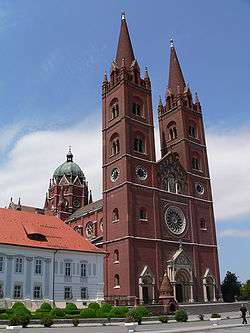Catholic Church in Croatia
| Catholic Church in Croatia | |
|---|---|
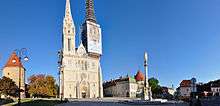 | |
| Classification | Catholic |
| Orientation | Catholic |
| Leader | Pope Francis |
| Region |
|
| Headquarters | Zagreb |
| Origin | 7th century AD |
| Members | 3,697,143 (2011) |
| Ministers | c. 3800[1] |
The Catholic Church in Croatia (Croatian: Katolicizam u Hrvatskoj) is part of the worldwide Catholic Church that is under the spiritual leadership of the Pope, Roman Curia and the Croatian Bishops' Conference. Its administration is centered in Zagreb, and it comprises 5 archdioceses, 13 dioceses and 1 Military Ordinariate. Current Croatian cardinal is Josip Bozanić, Archbishop of Zagreb.
There are an estimated 3.7 million baptized Roman Catholics in Croatia which make 86,3% of the population according to the 2011 census. The national sanctuary of Croatia is in Marija Bistrica, while the country's patron is Saint Joseph since the Croatian Parliament declared him to be in 1687.[2]
History
Early ages
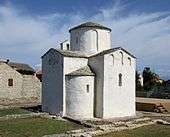
The Croats arrived in the area of present-day Croatia during the early part of the 7th century AD. They came in touch with the Christian natives and started to slowly accept Christianity. Byzantine and Frankish missionaries and Benedictines who were bringing Western cultural influences had a significant role in the christening of Croats. Croats had first contact with the Holy See in year 641 when the papal envoy Abbot Martin came to them in order to redeem Christian captives and the bones of the martyrs that Croats were keeping. There isn't much information about the Baptism of the Croats, but it is known that it was peacefully and freely accepted, and that it took place between the 7th and the 9th century. Byzantine emperor Constantine Porphyrogenitus wrote in his book De Administrando Imperio that the Byzantine Emperor Heraclius, during whose reign Croats came to the land between Drava river and the Adriatic Sea (present-day Croatia), "brought priests from Rome who he made into archbishop, bishop, priests and deacons, which then baptized Croats." Historical sources mention the christening of Croatian rulers Porga, Porin, Vojnomir, Višeslava, Borna, Ljudevit Posavski and others.
In the 9th century Croats have already been fully included in a large European Christian community. Croatian rulers Mislav (around 839), Trpimir I (852) and many others were building churches and monasteries. In year 879 Croatian duke Branimir wrote a letter to Pope John VIII in which he promised him loyalty and obedience. Pope John VIII replied with a letter on June 7, 879 in which he wrote that he celebrated a Mass at the tomb of St. Peter on which he invoked God's blessing on Branimir and his people. In year 925 Croatian King Tomislav was corresponding with Pope John X on the occasion of the first Church Council of Split. Pope's letter to the King Tomislav is the first international document in which a Croatian ruler was called rex (King) that is why Tomislav is considered to be the first Croatian king.
King Demetrius Zvonimir was crowned on October 8, 1076[3] at Solin in the Basilica of Saint Peter and Moses (known today as the Hollow Church) by Gebizon, a representative of Pope Gregory VII.[4][5] Zvonimir took an oath of allegiance to Pope, by which he promised his support in the implementations of the Church reforms in Croatia. After the Papal legate crowned him, Zvonimir in 1076 gave the Benedictine monastery of Saint Gregory in Vrana to the Pope as a sign of loyalty and as an accommodation for papal legates coming to Croatia.[6] At the time Benedictine monks were very active. They left an indelible mark on cultural and political life of the time.
Middle Ages
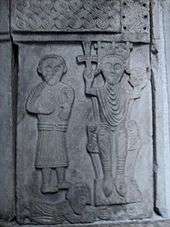
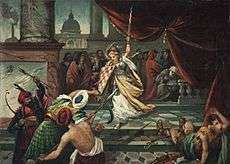
When Croatia lost its own dynasty and entered into a personal union with Hungary in 1102, the Benedictines were slowly dying out, while the mendicant orders, especially Franciscans and Dominicans were becoming more important. Religious and cultural formation of Croats was also strong influenced by Jesuits. Church writers from northern Croatia and Dubrovnik, which was a free center of the Croatian culture, have done a lot for standardization and expansion of the Croatian literary language. Since the 9th century there is in Croatia a unique phenomenon in the entire world of Roman Catholicism, liturgy that was held in Church Slavonic language with special Glagolitic script (Pope was allowing serving liturgy only in Latin). Despite the various disputes, Pope Innocent IV approved use of Church Slavonic language and the Glagolitic script to Filip, bishop of Senj, thus making Croats only Roman Catholics in the world that were allowed to use some other language in liturgy, while others had to use Latin until Second Vatican Council in 1962.[7] During the Croatian–Ottoman Wars that lasted from 15th to 19th century Croats strongly fought against the Turks which resulted in the fact that the westernmost border of the Ottoman Empire and Europe became entrenched on the soil of the Croatian Kingdom. In 1519, Croatia was called the Antemurale Christianitatis by Pope Leo X.
The Church in the Austrian/Austro-Hungarian Empire
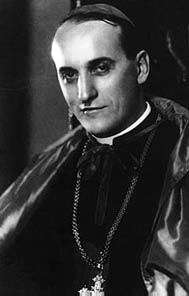
The Austrian Empire signed a concordat with the Holy See in 1855 which regulated the Catholic Church within the empire.[8]
The Church in the Kingdom of Yugoslavia
In Yugoslavia, the Croatian bishops were part of the Bishops' Conference of Yugoslavia.
The Serbian Orthodox Church acted as a de facto national church of the Kingdom of Yugoslavia. During this period, a Serbian Orthodox church was built on the almost entirely Catholic island of Vis and a part of the local population began converting.[9]
The Church in the Independent State of Croatia
In 1941, Nazi puppet state, so-called Independent State of Croatia (NDH), was established by the fascist dictator Ante Pavelić and his Ustaše movement. The Ustaša regime pursued a genocidal policy against the Serbs (who were Eastern Orthodox Christians), Jews and Romani. Historian Michael Phayer wrote that the creation of the NDH was initially welcomed by the hierarchy of the Catholic Church and by many Catholic priests. Ante Pavelić was anti-Serb and pro-Catholic, viewing Catholicism as an integral part of Croat culture.[10] British writer Peter Hebblethwaite wrote that Pavelić was anxious to get diplomatic relations and a Vatican blessing for the new 'Catholic state' but that "neither was forthcoming".
The Archbishop of Zagreb, Aloysius Stepinac, wanted Croatia's independence from the Serb dominated Yugoslav state which he considered to be "the jail of the Croatian nation", so he arranged the audience with Pius XII for Pavelić.[10] Vatican under Secretary of State Giovanni Montini minutes before the meeting noted that no recognition of the new state could come before a peace treaty and that "The Holy See must be impartial; it must think of all; there are Catholics on all sides to whom the [Holy See] must be respectful."[11] The Vatican refused formal recognition of NDH but Pius XII sent a Benedictine abbot Giuseppe Ramiro Marcone as his apostolic visitor. Pius was criticized for his reception of Pavelić but he still hoped that Pavelić would defeat communist Partisans and reconvert many of the 200,000 who had left the Catholic Church for the Serbian Orthodox Church since World War I.[10]
Many Croatian nationalist clergy supported the Pavelić's regime push to drive out Serbs, Gypsies and Jews, or force their conversion to Catholicism.[12] Despite that, Pavelić told Nazi Foreign Minister von Ribbentrop that while the lower clergy supported the Ustaše, the bishops, and particularly Archbishop Stepinac, were opposed to the movement because of "Vatican international policy".[11] Phayer wrote that Stepinac came to be known as jeudenfreundlich (Jew friendly) to the Nazi-linked Ustaše regime, and suspended a number of priest collaborators in his diocese.[13] In December 1941, Chetniks killed a group of five nuns near Goražde.
Archbishop Stepinac made many public statements criticizing developments in the NDH. On Sunday May 24, 1942 to the irritation of Ustaša officials he used the pulpit and a diocesan letter to condemn genocide in specific terms:
All men and all races are children of God; all without distinction. Those who are Gypsies, Black, European, or Aryan all have the same rights.... for this reason, the Catholic Church had always condemned, and continues to condemn, all injustice and all violence committed in the name of theories of class, race, or nationality. It is not permissible to persecute Gypsies or Jews because they are thought to be an inferior race.[14]
He also wrote a letter directly to Pavelić on February 24, 1943, stating:
The very Jasenovac camp is a stain on the honor of the NDH. Poglavnik! To those who look at me as a priest and a bishop I say as Christ did on the cross: Father forgive them for they know not what they do.[15]
Thirty-one priests were arrested following Stepinac's July and October 1943 explicit condemnations of race murders being read from pulpits across Croatia.[16] Martin Gilbert wrote that Stepinac, "who in 1941 had welcomed Croat independence, subsequently condemned Croat atrocities against both Serbs and Jews, and himself saved a group of Jews".[17]
Communist Yugoslav Partisans killed priests Petar Perica and Marijan Blažić on the island of Daksa on October 25, 1944. The Partisans killed fra Maksimilijan Jurčić near Vrgorac in late January 1945.[18]
The Church in communist Yugoslavia
The National Anti-Fascist Council of the People's Liberation of Croatia (ZAVNOH) originally foresaw a greater degree of religious freedom in the country. In 1944 ZAVNOH still left open the possibility of religious education in schools.[19] This idea was scuttled after Yugoslav leader Josip Broz removed secretary of the Central Committee of the Communist Party of Croatia Andrija Hebrang and replaced him with hardliner Vladimir Bakarić.[20]
In 1945, the retired bishop of Dubrovnik, Josip Marija Carević, was murdered by Yugoslav authorities.[21] Bishop Josip Srebrnić was sent to jail for two months.[22] After the war, the number of Catholic publications in Yugoslavia decreased from one hundred to only three.[23]
In 1946, the communist regime introduced the Law on State Registry Books which allowed the confiscation of church registries and other documents.[24] On January 31, 1952, the communist regime officially banned all religious education in public schools.[25] That year the regime also expelled the Catholic Faculty of Theology from the University of Zagreb, to which it was not restored until democratic changes in 1991.[26][27]
In 1984, the Catholic Church held a National Eucharistic Congress in Marija Bistrica.[28] The central mass held on September 9 was attended by 400,000 people, including 1100 priests, 35 bishops and archbishops, as well as five cardinals. The mass was led by cardinal Franz König, a friend of Aloysius Stepinac from their early studies. In 1987 the Bishops' Conference of Yugoslavia issued a statement calling on the government to respect the right of parents to obtain a religious education for their children.[29]
The Church in the Republic of Croatia
After Croatia declared its independence from Yugoslavia, Roman Catholic Church regained its full freedom and influence. During the Croatian War of Independence Catholicism and Orthodoxy were often cited as a basic division between Croats and Serbs, which led to a massive destruction of Churches (total of 1,426 were destroyed or damaged). In the Republic of Croatia Catholic Church has defined its legal position as autonomous in some areas, thus making it able to: provide religious education in state primary and secondary schools to those students who choose it, establish Catholic schools and conduct pastoral care among the Catholics in the armed forces and police. Through the ratification of treaties between the Holy See and Croatia on April 9, 1997, treaties that regulate legal issues, cooperation in education and culture, conducting pastoral care among the Catholics in the armed forces and police and financing Church from the state budget came into force. As regards to financing, the Church has received the following amounts of money over the last decade: 2001; 461.3 bln kunas, 2004-2007; 532 bln kunas, 2008-2011;475.5 bln kunas, 2012-2013; 523.5 bln kunas, plus around 200 million kunas per each year for teachers of religious studies in schools, around 60 million kunas for maintenance churches which are considered to be a cultural heritage etc.[30]
Catholic Church in Croatia is very active in social and political life. The church has implemented a number of actions in conservative spirit in order to promote its values such as: non-working Sunday, punishment of the crimes of the communist era, introducing religious education in schools, protection of marriage as the union of a man and a woman (2013 referendum), opposition to abortion (campaign: "Protecting human life from conception to natural death"), opposition to euthanasia, opposition to natural methods of family planning and the treatment of infertility, and opposition to artificial birth control methods.
With Croatian independence, the Croatian Bishops' Conference was formed. The Croatian Bishops' Conference established Croatian Catholic Radio in 1997.[31]
Demographics
The published data from the 2011 Croatian census included a crosstab of ethnicity and religion which showed that a total of 3,697,143 Catholic believers (86.28% of the total population) was divided between the following ethnic groups:[32]
- 3,599,038 Catholic Croats
- 22,331 Catholic believers of regional affiliation
- 15,083 Catholic Italians
- 9,396 Catholic Hungarians
- 8,521 Catholic Czechs
- 8,299 Catholic Roma
- 8,081 Catholic Slovenes
- 7,109 Catholic Albanians
- 3,159 Catholic Slovaks
- 2,776 Catholic believers of undeclared nationality
- 2,391 Catholic Serbs
- 1,913 Catholic believers of other nationalities
- 1,847 Catholic Germans
- 1,692 Catholic Ruthenians
- 1,384 Catholic believers of unknown nationality
- 1,339 Catholic Ukrainians
- other individual ethnicities (under 1,000 people each)
Hierarchy
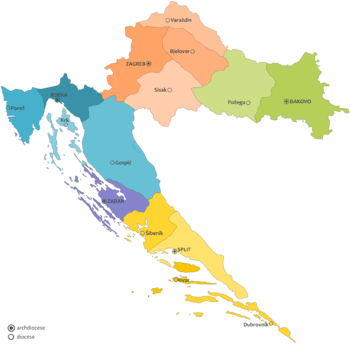
Within Croatia the hierarchy consists of:
| Archdioceses and dioceses | Croatian name | (Arch-)Bishop | Est. | Cathedral | Weblink |
|---|---|---|---|---|---|
| Archdiocese of Zagreb | Zagrebačka nadbiskupija Archidioecesis Zagrebiensis |
Josip Bozanić | 1093 | Zagreb Cathedral | |
| Eparchy of Križevci (Greek-Catholic) | Križevačka eparhija | Nikola Kekić | 1777 | Križevci Cathedral Zagreb Co-cathedral |
|
| Diocese of Varaždin | Varaždinska biskupija | Josip Mrzljak | 1997 | Varaždin Cathedral | |
| Diocese of Sisak | Sisačka biskupija | Vlado Košić | 2009 | Sisak Cathedral | |
| Diocese of Bjelovar-Križevci | Bjelovarsko-križevačka biskupija | Vjekoslav Huzjak | 2009 | Bjelovar Cathedral Križevci Co-cathedral |
|
| Archdiocese of Đakovo-Osijek | Đakovačko-osiječka nadbiskupija | Đuro Hranić | 4th century | Đakovo Cathedral | |
| Diocese of Požega | Požeška biskupija Dioecesis Poseganus |
Antun Škvorčević | 1997 | Požega Cathedral | |
| Diocese of Srijem (in Serbia) | Srijemska biskupija | Đuro Gašparović | 2008 | Cathedral Basilica of St. Demetrius | |
| Archdiocese of Rijeka | Riječka nadbiskupija | Ivan Devčić | 1920 | Rijeka Cathedral | |
| Diocese of Gospić-Senj | Gospićko-senjska biskupija | Zdenko Križić | 2000 | Gospić Cathedral Senj Co-cathedral |
|
| Diocese of Krk | Krčka biskupija | Ivica Petanjak | 900 | Krk Cathedral | |
| Diocese of Poreč-Pula | Porečko-pulska biskupija | Dražen Kutleša | 3rd century | Euphrasian Basilica Pula Cathedral |
|
| Archdiocese of Split-Makarska | Splitsko-makarska nadbiskupija | Marin Barišić | 3rd century | Split Cathedral Makarska Co-cathedral |
|
| Diocese of Dubrovnik | Dubrovačka biskupija | Mate Uzinić | 990 | Dubrovnik Cathedral | |
| Diocese of Hvar-Brač-Vis | Hvarsko-bračko-viška biskupija | Slobodan Štambuk | 12th century | Hvar Cathedral | / |
| Diocese of Kotor (in Montenegro) | Kotorska biskupija | Ilija Janjić | 10th century | Kotor Cathedral | |
| Diocese of Šibenik | Šibenska biskupija | Tomislav Rogić | 1298 | Šibenik Cathedral | |
| Archdiocese of Zadar | Zadarska nadbiskupija | Želimir Puljić | 1054 | Zadar Cathedral | |
| Military Ordinariate | Vojni ordinarijat | Jure Bogdan | 1997 |
The bishops are organized into the Croatian Conference of Bishops, which is presided by the Archbishop of Zadar Mons. Želimir Puljić.
There are also historical bishoprics, including:
As of 2009, there were 1570 Catholic parishes in Croatia.[33]
Franciscans
There are three Franciscan provinces in the country:
- the Franciscan Province of Saints Cyril and Methodius based in Zagreb,
- the Franciscan Province of Saint Jerome based in Zadar and
- the Franciscan Province of the Most Holy Redeemer based in Split.
Other orders
- Croatian Dominican Province
- Croatian Province of the Society of Jesus
- Croatian Salesian Province of Saint Don Bosco
- Croatian Carmelite Province of Saint Joseph the Father
Places of Pilgrimage of the Croats
Notable people
- Juraj Dobrila
- Marija Krucifiksa Kozulić, established the only indigenous community of nuns founded in the Archdiocese of Rijeka
- Franjo Kuharić (Cardinal before Josip Bozanić)
- Antun Mahnić, initiator of the Croatian Catholic Movement
- Ivan Merz, blessed layman and Catholic activist
- Franjo Šeper
- Alojzije Stepinac
- Josip Juraj Strossmayer
See also
References
- ↑ http://www.autograf.hr/koliko-ima-pedofila-u-crkvi/
- ↑ http://www.sabor.hr/Default.aspx?art=28406 "At its season on June 9th and 10th 1687 Croatian Parliament encouraged by the Bishop of Zagreb Martin Borković, unanimously declared St. Joseph to be the patron of the Croatian Kingdom"
- ↑ Dominik Mandić, Rasprave i prilozi iz stare hrvatske povijesti, Institute of Croatian history, Rome, 1963, pages 315, 438.
- ↑ Demetrius, Duke of Croatia and Dalmatia He was granted the royal title by Gregory after pledging "Peter's Pence" to the Pope.
- ↑ Tomislav Raukar Hrvatsko srednjovjekovlje, Školska knjiga, Zagreb, 1997. ISBN 953-0-30703-9, str. 49
- ↑ Florin Curta: Southeastern Europe in the Middle Ages, 500-1250, p. 262
- ↑ http://www.benedictines-cib.org/meetings/2009Croatia/Jozo_Crkva_u_Hrvatskojna_hrv.pdf
- ↑ Ljiljana Dobrovšak. Ženidbeno (bračno) pravo u 19. stoljeću u Hrvatskoj
- ↑ History of the island of Vis
- 1 2 3 Phayer, Michael. The Catholic Church and the Holocaust 1930-1965, Indiana University Press; 2000, pg. 32.
- 1 2 Hebblethwaite, Peter. Paul VI, the First Modern Pope, Harper Collins Religious; 1993; pp. 153-157, 210-211
- ↑ Evans, Richard J., The Third Reich at War, Penguin Press; New York 2009, pp. 158-159
- ↑ Phayer, p. 86.
- ↑ Apud: Dr. H. Jansen, Pius XII: chronologie van een onophoudelijk protest, 2003, p. 151
- ↑ Alojzije Viktor Stepinac: 1896-1960 Archived May 30, 2003, at the Wayback Machine.
- ↑ Phayer, p. 47.
- ↑ Gilbert, Martin. The Righteous - The Unsung Heroes of the Holocaust, Doubleday (2002), pp. 203, 466; ISBN 0385 60100X.
- ↑ Partizan Jure Galić: Moji suborci pobili su 30 Vrgorčana, Slobodna Dalmacija
- ↑ Tanner (1997), p. 164
- ↑ Tanner (1997), p. 165
- ↑ Religious Communities in Croatia from 1945 to 1991
- ↑ Akmadža, Miroslav. Katolička crkva u Hrvatskoj i komunistički režim 1945 - 1966.. Rijeka: Otokar Keršovani, 2004. (pg. 69)
- ↑ Mitja Velikonja. Religious Separation and Political Intolerance in Bosnia-Herzegovina. Texas A&M University Press, 2003. (p. 200)
- ↑ Miroslav Akmadža. Oduzimanje crkvenih matičnih knjiga u Hrvatskoj u vrijeme komunizma
- ↑ Akmadža, Miroslav. Katolička crkva u Hrvatskoj i komunistički režim 1945-1966.. Biblioteka Svjedočansta. Rijeka, 2004. (pg. 93)
- ↑ Goldstein, Ivo. Croatia: A History . McGill Queen's University Press, 1999. (pg. 169)
- ↑ Catholic Faculty of Theology History
- ↑ How Gospa destroyed the SFRY, Globus
- ↑ Sabrina P. Ramet. Catholicism and politics in communist societies. Duke University Press, 1990. (p. 194)
- ↑ http://www.jutarnji.hr/ekskluzivno--koliko-se-iz-proracuna-izdvaja-za-vjerske-zajednice--sest-milijardi-kuna-hrvatska-je-platila-kaptolu-u-10-godina-/1236185/
- ↑ Hrvatski katolički radio u povodu 10. obljetnice emitiranja, Glas Koncila
- ↑ "4. Population by ethnicity and religion". Census of Population, Households and Dwellings 2011. Croatian Bureau of Statistics. Retrieved 2012-12-17.
- ↑ http://arhiva.nacional.hr/clanak/57295/kad-tata-sluzi-misu
Sources
- Phayer, Michael. The Catholic Church and the Holocaust 1930-1965, Indiana University Press; 2000
- Tanner, Marcus (1997). Croatia: A Nation Forged in War. Yale University Press. ISBN 0-300-07668-1.
External links
| Wikimedia Commons has media related to Roman Catholicism in Croatia. |
